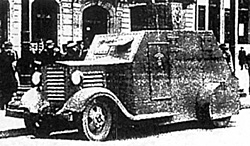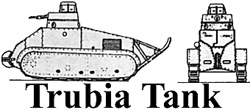
At the time of the military "Alzamiento" in July 18th 1936, the armoured vehicles depot was scarce and of a limited military value due to its age and to the bad maintenance conditions, with the only exception of some fifty "autoametralladoras" (self propelled machine guns) for police duties.
The AFV were ten light Renault FT-17 with machine guns (7mm. Hotchkiss 1914 models) located at the "Regimientos Ligeros de Carros de Combate nÝ 1 y 2", four Schneider CA-1 M-1916 at the old "Bateria de Asalto", located in the Madrid's "Parque de Artilleria" (Artillery Depot), plus two other ones at the "Escuela de Automobilismo Pesado" (Heavy Vehicles School) in Segovia. There were another FT-17 and a Fiat 3000A at the "Escuela Central de Tiro"(Central Shooting school) four experimental Trubia A and two Landesa 1934. Under heavy repairing there were four FT-17 more. It amounts 28 different AFV from various sources and different capability according their situation.
There were around twenty wheeled AFV "Camiones Protegidos" (Protected lorries) 1921 Models, survivors from the Morocco campaign and that were located at different military units either in Melilla or in the peninsula. Plus forty eight armoured cars "Bilbao" 1923 Models, i.e. the self propelled machine guns used by the Guardias de Asalto de la Policia (Police Assault Guards Corps), and the so called "Grupo de Autoametralladoras-canon" (Self propelled machine guns-cannons) in the Cavalry Division.
The country split between two enemy sides, and two geographical zones, distributed the aforementioned vehicles between the two fighting armies.
Government forces had six FT-17 tanks, four CA-1, a Fiat-3000A, forty three Bilbao cars and a few Camiones Protegidos.
 On the other side, the nationalist forces could gather around twenty armoured vehicles: six FT-17, three Trubia A, five Bilbao and five Camiones Protegidos.
On the other side, the nationalist forces could gather around twenty armoured vehicles: six FT-17, three Trubia A, five Bilbao and five Camiones Protegidos.
Almost from the very begining of the struggle, and specially at the Government s side appeared a collection of armoured lorries, improvised or just made for the circumstances, the well known "tiznaos", built most of the times in a craft way by the local iron factory , with a mere piling up of steel or iron plate screwed on commercial lorries, giving rise to the widest range of models, most with a low tactical value.
From the beginning of the fight, both sides used the different armour they had in the war actions against their foes.
For instance, on July 19th there were in Madrid two FT-17 tanks that were used against the "Regimiento de Artilleria a Caballo" (Mounted Artillery Regiment), and the following day, July 20th those tanks, plus a Schneider, and two Bilbao self propelled machine guns participated at the "Cuartel de la Montana" attack.
A few days later, the five Renault FT-17 which belonged to the "Regimiento de Carros de Combate 1" (First Tank Regiment) were sent to the "Alto del Leon" heights, at Guadarrama Sierra, and they fought there until the arrival of the Bilbao cars from the Cavalry "Grupo de autoametralladoras canon."
At the Column formed by Riquelme in order to attack Toledo' Alcazar, there were two heavy tanks Schneider CA-1, one of them resulted damaged by the defenders using handgrenades, and the latter went back to Madrid in September.
The tanks and the armoured cars under the Popular militia's hands participated along all August in the combats held with the nationalist in Badajoz, Caceres and Toledo. Such encounters made three Renault and eight selfpropelled machinegun Bilbao cars and a couple of tiznaos become casualties.
North of Spain, the Trubia and Landesa tanks were used by both sides on the attack and the defence in Oviedo and Gijon, being destroyed two of them.
The five Renault FT-17 held by the nationalist in Zaragaza (Saragossa) were sent in a Columna Movil (Mobile Column) that was risen as a reserve by General Cabanellas, and that were well used during August and September along the three fronts opened in Aragon region. One of those tanks was destroyed on the 24th of September.
After a couple months of war, the armoured vehicles were, on the 30th of September, after the first arrival of foreign material, as follows:
| Type | Republicans | Nationalist | Total |
|---|---|---|---|
| CA-1 | 2 | 2 | 4 |
| FT-17 | 3 | 4 | 7 |
| Trubia | - | 2 | 2 |
| Landesa | 1 | - | 1 |
| Bilbao | 23 | 12 | 15 |
| TOTAL | 29 | 20 | 49 |
More AFVs in SCW
Related
Back to Abanderado Vol. 2 No. 1 Table of Contents
Back to Abanderado List of Issues
Back to MagWeb Master Magazine List
© Copyright 1997 by Rolfe Hedges
This article appears in MagWeb (Magazine Web) on the Internet World Wide Web. Other military history articles and gaming articles are available at http://www.magweb.com